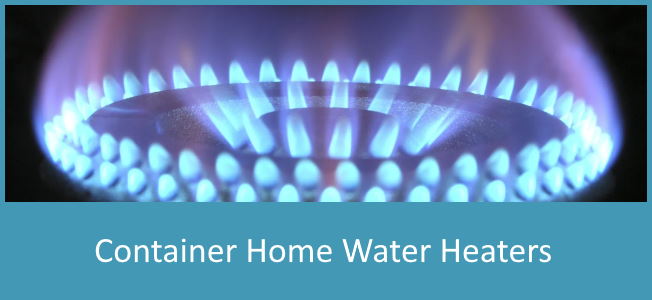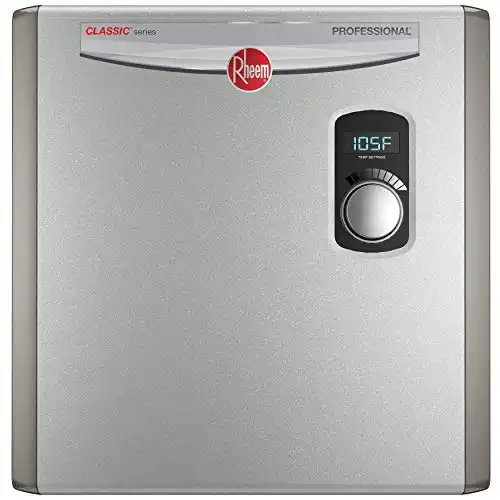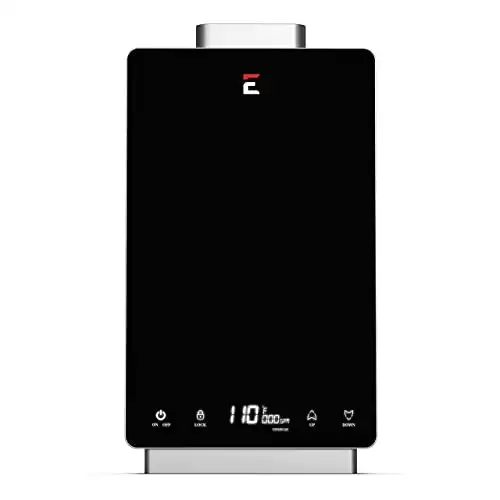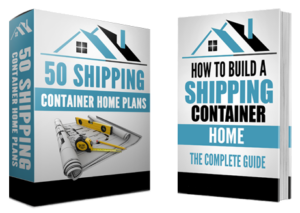Moving into a new container home means thinking about the appliances you’ll use and where you’ll put them. And a water heater is certainly toward the top of that list, enabling you to take showers, wash dishes, and more.
In many cases, a container home is designed to be smaller than a conventional home, which means less space for a water heater, but also potentially less need for hot water.
Balancing the available water heater options with the needs of your container home is a tricky subject, so we’re here to help. Below we’ll describe everything you need to know about container home water heaters and give our recommendations for the best ones.
Disclosure: This post contains affiliate links, meaning that we may receive a small commission (at no additional cost to you) on any purchases you make after clicking on these links. Click here for more information
Water Heater Energy Sources
You may remember the law of conversation of energy from high school physics, which states that energy is never created or destroyed, only changed from one form to another. Water heaters are all about converting things like electrical, chemical, or solar energy into thermal energy which ultimately increases the temperature of water through heat transfer.
While every water heater’s end result is hot water, the input can vary quite a bit. Here are a few of the most common energy input types for hot water heaters.
Petroleum
Petroleum is a catch-all for various forms of hydrocarbons, holistically referred to as oil and gas, that are burned to create thermal energy. Because of this, any hot water heater with a petroleum-based energy source will require some type of ventilation. Here are the three different petroleum fuels you’re likely to encounter when shopping for water heaters.
Natural Gas
Natural gas is an efficient, clean-burning fuel that has increased in popularity (and decreased in cost) thanks to the fracking technology you may have heard about on the news. It is naturally occurring inside the earth’s crust and doesn’t require refining to produce.
Natural gas is measured in sold either by volume (such as Ccf meaning 100 cubic feet or Mcf meaning 1,000 cubic feet) or thermal energy content (most commonly therm which equals 100,000 BTUs, which in turn is the approximate heat energy from burning 1 Ccf of natural gas).
In most cases, natural gas is delivered to homes via an underground pipeline and stays in it’s gaseous state. However, in other use cases (such as vehicles) natural gas can be cooled (LNG) to liquid form or highly compressed (CNG) which makes it take up much less room.
Propane
Propane is a byproduct of petroleum refining or processing natural gas into other products and is not naturally occurring. It is often mixed with other related gases and compressed, then sold as liquified propane (LP) or liquified propane gas (LPG).
Propane is typically sold in steel storage tanks which much be periodically replaced when empty. Due to its chemical properties, propane can be compressed into a liquid at a much lower pressure than natural gas, hence why it is transported and stored in relatively inexpensive steel cylinders.
Fuel Oil
Fuel oil which may also be called heavy oil, furnace oil, or heating oil is another product of petroleum distillation. It is a much heavier fuel than other common distillates like gasoline and jet fuel, and is basically only eclipsed in density by the bitumen used to make asphalt. Fuel oil is a liquid at standard temperature and pressure, making it much easier to transport and store and enabling customers to buy it by the gallon.
While fuel oil is effective at heating, it is known as a particularly ‘dirty’ fuel and is not a common choice for most modern homes water heaters.
Electricity
Electricity is somewhat of a tricky energy source because you can’t go out and drill for it or otherwise capture it directly from nature. Rather, it is an intermediate energy source that is prevalent because it can be efficiently transmitted and stored.
Electricity is generated via various means (solar, wind, gas, coal, nuclear, etc.), but that is really beyond the scope of the article. The assumption here is that you have access to electrical energy from your local utility provider, and this energy can be used for heating water.
Electric hot water heaters use a resistive heating element, which is 100% efficient at converting electrical energy into thermal energy. However, because electricity must be generated from another energy source, the overall efficiency is much less due to this additional step.
Therefore, while electric water heaters are some of the least expensive to purchase, their operating costs are typically higher than other choices.
Solar
Our last energy source category includes energy that is right in front of us, waiting to be captured and used for free. This includes energy directly from the sun, and also energy harnessed indirectly from the sun via the air and ground.
Solar Thermal
Solar thermal systems uses radiant heat from the sun to increase the temperature of water. This typically takes place in roof-mounted panels which contain fluid running in dark tubes. Sometimes this is the actual water you’ll be using, but often its another liqud that gives it’s heat energy to the water in a heat exchanger.
Note that solar thermal panels are not to be confused with photovoltaic solar panels, which convert the sun’s energy directly into electricity. Using a solar thermal panel is MUCH more efficient than using a photovoltaic panel to power an electrical resistance water heater.
Solar thermal hot water heaters are perfectly free to use, but they only work during the daytime and work best on clear, sunny days. Therefore, solar thermal systems are almost always used to supplement another type of water heater.
Heat Pump
Heat pump systems extract heat from a body of water, the air or ground (geothermal), move it, and use it in another location. We consider this a form of solar energy because ultimately the water, air, and ground on the earth are heated by the sun.
As far as how it works, think of a refrigerator: it extracts heat from the air inside the cooled cabinet (cooling it off), then releases that heat into the kitchen (heating it up). A heat pump hot water heater basically does this but in reverse.
It takes heat energy from the air or ground and adds it to water, making it warmer. How is it possible to take heat from something cold and move it to something warm, which seems to defy logic?
Well, it requires the vapor-compression refrigeration cycle and it’s what your air conditioner, refrigerator, and heat pump all use. However, heat pumps work best in warmer areas where there is plenty of heat to capture.
Heat pumps do require electricity, but the electricity is powering a mechanical process that harnesses existing heat, instead of changing the electrical energy directly into heat like an electrical resistance heater. For this reason, heat pumps commonly have efficiencies of 200% or more.
While you’re most likely to encounter a heat pump in a hybrid water heater (discussed later), there are other systems that ‘piggyback’ off the heat pumps primarily used for heating and cooling your house. These so-called desuperheaters allow excess heat to be used for heating water instead of exhausted outdoors.
Water Heater Types
Now we turn to the specific types of water heaters available, meaning how they physically heat and distribute the water. For each type, there is often more than one energy source available is available. For instance, you can get both electric and gas tankless water heaters.
Traditional Storage Water Heater
Once the most common water heater type of years past, the traditional variety is starting to decrease in popularity. A storage water heater uses an insulated tank to store a large quantity of heated water that is ready to be used. A common size for a single-family home is 30-50 gallons. For container homes, the large overall size of these water heaters makes them uncommon.
The inherent lack of efficiency for a storage water heater is obvious: even if you only need hot water one time per day, the heater is keeping all the water in the tank hot 24 hours a day. These water heaters can provide a lot of hot water at once, but the music stops as soon as the tank is empty and you’ll have to wait a good while for the new, cold water to be heated.
Storage water heaters can use petroleum or electric energy sources and are usually part of a solar thermal system as well.
Tankless Water Heater
A tankless water heater, sometimes called an on-demand water heater or an instantaneous water heater, is a newer technology. They have much larger and more efficient heating elements than storage models so that they can heat the water up to the needed temperature as it passes through the system in a matter of seconds.
Tankless water heaters take up much less space than other types because, well, they don’t have a tank. You can mount smaller, point of use models in a wall cabinet or under a sink. Larger models that can support multiple simultaneous hot water users are still wall-mounted and relatively slim.
Tankless water heaters are efficient because they only turn on when you need hot water, sitting dormant the rest of the time. And because they produce water instantaneously, they can keep producing it indefinitely in case your entire family wants to take showers back to back.
There are some downsides to on-demand water heaters though. They can only raise the temperature so much before it exits the system, meaning especially cold input water may never get hot enough for your preference. And all tankless water heaters have a flowrate limitation: they can only support so much hot water at a time.
Hybrid Hot Water Heater
A Hybrid Hot Water Heater is so named because it combines elements of a storage hot water heater with heat pump technology. They look similar to a storage water heater with an equivalently sized tank. The difference is in how they work.
The primary functional mode of a hybrid hot water heater is the heat pump. It extracts heat from the air and adds it to the water. The hybrid name comes in because there is a secondary mode of operation that uses a conventional heating element. This is basically a backup, in case the heat pump is not able to extract enough heat.
In normal operation, the heat pump is doing all the heating, which is why the energy usage of a hybrid hot water heater is so much less than a storage hot water heater. The major downside is cost, although most people generally agree that the added cost can be made up for with just a few years of energy savings.
Much like storage hot water heaters, hybrids can only provide a set amount of hot water before the tank is emptied. And in addition to being of similar size, they also require even more care about their placement. Put them in a tiny closet and they’ll quickly take all the heat out of the air, forcing them to go into the less efficient secondary mode of operation.
Therefore, hybrid hot water heaters need a larger room or plentiful access to makeup air. For these reasons, plus their large physical size, they are typically not used in many container homes.
Important Hot Water Heater Specifications and Data
Now that you have an idea of the specific types of water heaters, you’re probably curious how to select the right one for your location, design, and use case. Let’s start by discussing some of the common specifications used both for water heaters and the devices they supply with hot water.
Not every datapoint pertains to every situation and water heater type, as you’ll see. But familiarity with these metrics will help you better understand the possible tradeoffs when we share our recommended water heater models in the next section.
Physical Size and Location
As described above, hybrid and storage water heaters both have large tanks. For container homes, especially tiny or small ones, this additional space requirement can be hard to find. In comparison, on-demand water heaters are much more compact, though they get very hot so you’ll need to be careful of placement.
Remember that for any water heater with a tank, you ideally want it as close as possible to your kitchen and bathroom as possible. Additionally, keep in mind that any water heater that uses petroleum fuel will need a vent.
Efficiency Rating
In the United States, federal regulations like Energy Star govern the efficiency of appliances like water heaters. Other countries often have similar rules.
The best way to think about the efficiency of a hot water heater is with a combined measurement known as the energy factor (EF). The EF measures the amount of hot water produced per the amount of input energy consumed in a day. It also includes allowances for things like standby losses in tanks. The higher the EF, the more efficient the water heater. For electric hot water heaters, you may see this expressed in watts instead of BTUs per hour (3.412 BTUs/hr = 1 Watt)
Heating Performance
British Thermal Units (BTUs) are the most common measure of heating performance. The larger the amount of BTUs, the more energy the water heater can consume and thus the faster it can heat water.
For on-demand heaters specifically, the temperature rise is another important performance characteristic. It measures how much the water heater can raise the temperature of the water for a given flowrate. At higher flow rates, the water is heated less for a given size heater.
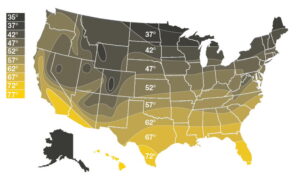
You have to combine a water heater’s temperature rise with the groundwater temperature in your area to ensure that your water heater will have enough capacity. A good goal is to try to have 110 degrees F water coming out of your tankless water heater, but you can adjust that to your needs.
Tank Capacity
Capacity is most relevant for storage and hybrid hot water heaters, in other words, those that have tanks. The capacity is simply the size of the tank, typically measured in gallons or liters.
You can use the tank capacity along with information from your water devices to estimate how long your hot water will last. For instance, if you have a 2.5 gallon per minute (GPM) showerhead and a 40-gallon hot water heater, you have approximately 16 minutes of hot water before you’ll run out.
This of course assumes no other devices are simultaneously using the hot water. In reality, you may want to plan on multiple hot water users and plan your tank capacity accordingly.
One caveat you may have noticed. As you use water out of the tank, that water is being refilled and heated on an ongoing basis. So in reality, you’ll get more than 40 gallons of hot water out of a 40-gallon tank and our previous calculation was a bit of a simplification.
To account for this, you may sometimes see a related measurement called the First Hour Rating (FHR). This measures the amount of hot water a storage heater can provide in an hour, starting with a full tank of hot water. So it factors in not only the tank capacity but also the speed of heating within the tank.
Water Flowrate
For tankless hot water heaters, the flowrate is used in lieu of the tank capacity. The flowrate is typically measured in GPM and expressed how much hot water the heater can produce.
Going back to the previous example, if you have a 2.5 GPM showerhead and a 3 GPM hot water heater, you should be able to take a hot shower for as long as you want. But remember, that flowrate is based on a given temperature rise. If the water entering your house is especially cold and you really like hot water, you may get 3 GPM out of the heater, but it may only be warm instead of hot! You’ll need to be mindful of a unit’s maximum temperature rise along with the average water supply temperature in your area.
One interesting phenomenon of tankless hot water heaters is the minimum flow rate. In short, the water heater knows when to turn on by measuring the water that flows through it when you turn on a hot water device. A small switch controls this behavior and is often triggered at somewhere around 0.5 GPM.
This means that if you just barely turn on the hot water, perhaps to get warm water to wash your hands, there may not be enough water flowing past the switch to turn on the heater. The result is that the water heater never turns on and you end up with cold water. This is something to think through and research when you look at tankless heaters.
Utility Requirements and Availability
In the energy source section at the beginning of the article, we made it clear that some form of energy input is needed for your water heater. With the exception of solar thermal which gets all of its energy from the sun, this typically either means you’ll need to provide either access to either electricity or petroleum products.
For electricity, you’ll need to find out the voltage and amperage requirements. On-demand heaters have especially large electrical service requirements and may require adding a new circuit.
When it comes to the petroleum options, what you’ll need depends on your choices. For instance, with fuel oil, you’ll have an indoor or outdoor tank to deal with. By comparison, natural gas will require tapping into an existing gas line from a local utility company. Make sure you’re clear on not only what is available in your area, but what size pipes and other equipment are needed.
Home Size
This last detail isn’t actually related to the water heater itself, but rather, to where the water heater will be used. The size of your house drives two factors that affect your hot water heater: the length of your pipes and the number of hot water outlets.
Every foot of pipe between your hot water heater and where the hot water will be used is more surface area that will lose heat. With enough distance, you can get a noticeable drop in water temperature. Additionally, it means you’ll have to wait longer for hot water to appear as the long pipe full of cold water is replaced with hot water.
The number of hot water outlets is something we touched on earlier. More hot water being used in more places means your tank will be emptied faster or your tankless water heater will have its GPM rating exceeded. But remember, this only matters for simultaneous users!
Best Water Heaters for Your Container Home
In this section, we’ll share a few of our favorite hot water heaters using a variety of energy sources. Our focus is on tankless hot water heaters, as these are by far the most common choices for container home owners across the world.
Electric Tankless Water Heater
Rheem is a household name in both water heaters and other climate control devices, and their Professional Classic series is high-quality yet fairly affordable. The table below outlines how different models in the series perform regarding temperature rise at various GPM flowrates.
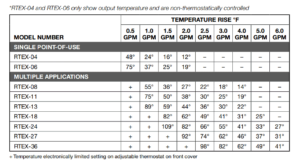
The RTEX-24 model with 24kW of power is a good choice for many container homeowners, even those in more northern climates.
Natural Gas and Propane Tankless Water Heater
If you’re looking for a tankless water heater fueled by natural gas, the offerings from Eccotemp are a good place to start. They have good reviews and an array of sizes to fit any container home design. The following table shows the temperature and flowrate mix of the model line.
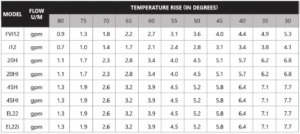
We’re especially fond of the Eccotemp i12 model, which has a sleek, modern design to go along with its impressive performance. It certainly does better in warmer climates, so be sure to reference the groundwater table map earlier in the article to ensure this model will meet your needs. Also, note that the i12 is available in both LP gas and natural gas configurations, so choose the right one for your application.
Installing your Hot Water Heater
When it comes time to install a hot water heater in your container home, you have two choices: DIY or professional install.
If you’re comfortable with DIY projects, are already building your entire container home anyway, you should consider a DIY install. Yes, you’ll need to keep the water lines leak-free and ensure you handle the gas or electric hookup appropriately. But both of these things can be covered by reading the instructions and perhaps watching some YouTube videos. Keep in mind that your local authorities may want to approve your installation, so check on this first.
If you don’t have the time or experience for a DIY install, hiring a professional plumber will ensure you have a worry-free installation. One thing to consider: some plumbers may not want to install a hot water heater you’ve purchased on your own, so check with them first. You may also find that they are able to get better, volume pricing on heaters through their wholesale account.
Final Thoughts
Anyone thinking about living in a container home has to think about details large and small, from insulation to appliances. Water heaters are one of the silent heroes of a home, steadfastly producing hot water for years to make your life more comfortable.
Picking the right water heater isn’t something you should need to do often. But when you’re building a new home or replacing an older model, it pays to do your research.
In this article, we’ve gone into great depth in the world of water heaters, covering everything from the various types to energy sources. And even though we don’t recommend several of these options for container homes, it’s important to understand all the products that are out there. We hope you’ve found our background explanation and recommendations helpful!

